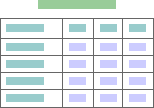 Show
All
Show
AllA table is made up of rows and columns of cells into which you can insert text and graphics.
There are different ways you can use tables, and you can customize your tables in a variety of ways to make them more attractive and easy to read: Present
information in a tabular format
Present
information in a tabular format
Use a table to present information in a grid-like format, such as timetables, product information, rates, and so on.

 Lay
out text and graphics on a page
Lay
out text and graphics on a page
When you lay out text and graphics on a page, you can use a table to arrange them. Tables are supported by virtually all Web browsers and are an easy way to lay out your pages.

 Work
with rows and columns
Work
with rows and columns
You can create more cells in your table by splitting one cell into two or more cells. You can also merge adjacent cells into one cell.

Once you have all the rows and columns you need in your table, you can set the row heights and column widths the way you want them.

You can define the row heights and column widths to be a percentage of the overall table size, a specific size in pixels, or set all rows and columns to be spaced uniformly.
 Control
text and table layout
Control
text and table layout
You can control how your table appears on the page by setting the table alignment — tables can be aligned to the left, right, or center of the page. The table below is centered.

You can also control the height and width of the table. For example, you can set the width of the table to 80 percent of the overall page width (or frame width, if the table is in a frame). If a site visitor resizes the browser window, the page size and table change accordingly. On pages that include a table and text, you can also specify whether you want text to flow around the sides of the table.
By specifying the way text appears inside each cell, you can control how much space there is between the border and text of a cell, and you can set the horizontal and vertical alignment of text. In addition, table text can be formatted like any other text — you can change the font style, size, color, and other attributes.
 Set
border specifications
Set
border specifications
You can customize the way borders look in your tables. Set the border color for the whole table, or set a different border color for individual cells. You can choose one color for the border, or, if you prefer a three-dimensional look, you can choose two colors — a light color and a dark color. You can also change the thickness of the outer border.

 Choose
backgrounds
Choose
backgrounds
You can choose background colors and pictures for your tables. Background colors can be used to shade specific columns or rows to add emphasis. You can use background pictures to add visual appeal to your tables.
You can set background colors and pictures for certain cells, or you can set them for the whole table.

 Create
captions and headers
Create
captions and headers
You can label or title your tables by adding a table caption. A table caption is placed above or below the table. You can also format the caption text.
To emphasize certain cells in your table, you can specify them as table headers. For example, in the table below, the first row and first column contain labels. They are formatted as table headers so that they stand out from the rest of the table. By default, a table header is formatted as bold text. However, you can modify the table header style and define additional properties for your table headers, such as shading.
